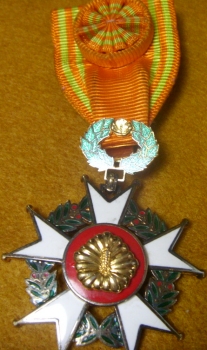
Order of Sports Merit 체육훈장 (體育勳章)
The Order of Sports Merit is awarded to those athletes who have distinguished themselves in international competition and includes competitions such as the Paralympics. It is also awarded to those in the sports industry, such as coaches and well as leaders in the various sports associations.
There are 2 news articles at the bottom of this page that sports enthusiasts may find interesting.
1973 SERIES
The Order of Sports Merit 체육훈장 was established on Jan. 25, 1973 in 5 classes under Decorations Law #2447. In some Korean government publications, the name of the Order is written as 휴육훈장 (休育勳章). The physical appearance of the Order of Sports Merit was finalized on Nov. 1, 1973 under Presidential Decree #6916 (Decorations Law Enforcement Decree). The Order follows the European usage of sashes, breast stars, etc., except for the 5th Class, which has a rosette on the ribbon. There is a women’s size in the 1st Class Cheongryong Medal. The center design, found on the pendants and breast stars, is described as a “Ceremonial Disk” 식판 centered on a “Ruby Disk” or “Carnelian Disk” 홍옥판. It is also found in the center of the lapel pins, but not on the ribbon bars. The dimensions for the width of the stripes on the ribbon bars and lapel pins, are not given in the legislation.
The Classes are:
- Cheongryong Medal 청룡장 (靑龍章) Blue Dragon. The pendant has a diameter of 50 mm and weighs 33.4 g. It is suspended from an 80 × 1,700 mm solid, pale orange (옅은오랜지) sash with no stripes. The breast star has a diameter of 70 mm and weighs 45.4 g. The ribbon bar is 38 × 10 mm. It is a pale orange with two gold stripes (금색), one on each side of the center. The lapel pin is 12 × 8 mm. It also has two gold stripes, with one on each side of the center.
- Cheongryong Medal 청룡장 (靑龍章) Blue Dragon, (sized) for Ladies. The pendant has a diameter of 50 mm and weighs 26.7 g. It is suspended from an 65 × 1,700 mm solid, pale orange (옅은오랜지) sash with no stripes. The breast star has a diameter of 55 mm and weighs 30.7 g. The ribbon bar is 38 × 10 mm. It is pale orange with two gold stripes (금색), with one on each side of the center. The lapel pin is 12 × 8 mm. It also has two gold stripes, with one on each side of the center.
- Maengho Medal 맹호장 (猛虎章) Brave Tiger. The pendant has a diameter of 55 mm and weighs 30.7 g. It is suspended from a 38 mm x 600 mm cravat. The cravat is lemon yellow (담황) with eight light green (연두) stripes, 1.5 mm wide, with four on each side of the center. The breast star has a diameter of 60 mm and weighs 33.4 g. The ribbon bar is 38 × 10 mm. It is lemon yellow with eight light green stripes, four on each side of the center. The lapel pin is 12 × 8 mm. It also has eight light green stripes, four on each side of the center.
- Geosang Medal 거상장 (巨象章) Great Hero, colossus, a giant. The pendant has a diameter of 50 mm and weighs 26.7 g. It is suspended from a 38 mm x 600 mm cravat which is lemon yellow (담황) with six light green (연두) stripes, each 1.5 mm wide, and with three on each side of the center. There is no breast star. The ribbon bar is 38 × 10 mm. It is lemon yellow with six light green stripes, three on each side of the center. The lapel pin is 12 × 8 mm. It also has six green stripes, with three on each side of the center.
- Baegma Medal 백마장 (白馬章) White Horse. The pendant has a diameter of 50 mm and weighs 26.7 g. It is suspended from a 38 × 100 mm breast ribbon which is lemon yellow (담황) with four light green (연두) stripes, each 1.5 mm wide, two on each side of the center. The ribbon bar is 38 × 10 mm. It is lemon yellow with four light green, two on each side of the center. The lapel pin is 12 × 8 mm. It also has four light green stripes, with two on each side of the center.
- Girin Medal 기린장 (麒麟章).1 The pendant has a diameter of 50 mm and weighs 26.7 g. It is suspended from a 38 × 100 mm breast ribbon which is lemon yellow (담황) with two light green (연두) stripes, each 2 mm wide, and with one on each side of the center. The ribbon bar is 38 × 10 mm. It is lemon yellow with two light green stripes, one on each side of the center. The lapel pin is 12 × 8 mm. It also has two light green stripes, with one on each side of the center.
1974 SERIES
There was a new Decorations Law Enforcement Decree issued in 1974, but there were no changes to the Order of Sports Merit.2
1984 SERIES
On Jan. 23, 1984, the Korean government made some significant changes to the physical size of the Order of Sports Merit.3 As far as the design, they are nearly identical in appearance to the earlier series, just sized differently. This legislation uses different terminology for the ribbon colors. Like the previous series, the Order follows the general European usage of sashes, breast stars, etc., except for the 5th Class, which has a rosette on the ribbon. The center design, found on the pendants and breast stars, is described as a “Ceremonial Disk” 식판 centered on a “Ruby Disk” or “Carnelian Disk” 홍옥판. It is also found in the center of the lapel pins, but not on the ribbon bars.
The classes are:
- Cheongryong Medal 청룡장 (靑龍章) Blue Dragon. The pendant has a diameter of 70 mm and weighs 67.0 g. It is suspended from an 80 × 1,800 mm solid, orange (주황색) sash with no stripes. The breast star has a diameter of 80 mm and weighs 78.5 g. The ribbon bar is 38 × 10 mm. It is orange with two light green (연두) stripes, 6 mm each, with one on each side of the 24 mm center. The lapel pin is 12 × 8 mm. It also has two light green stripes, 1.5 mm each, with one on each side of the 4 mm center.
- Cheongryong Medal 청룡장 (靑龍章) Blue Dragon, (sized) for Ladies. The pendant has a diameter of 50 mm and weighs 36.5 g. It is suspended from a 65 × 1,700 mm solid, orange (주황색) sash with no stripes. The breast star has a diameter of 55 mm and weighs 40.0 g. The ribbon bar is 38 × 10 mm. It is orange with two light green (연두), 6 mm each, with one on each side of the 24 mm center. The lapel pin is 12 × 8 mm. It also has two light green stripes, 1.5 mm each, and with one on each side of the 4 mm center.
- Maengho Medal 맹호장 (猛虎章) Brave Tiger. The pendant has a diameter of 60 mm and weighs 48.0 g. It is suspended from a 38 mm x 600 mm cravat. The cravat is orange (주황색) with eight light green (연두) stripes, 1.5 mm each, with four on each side of the 13 mm center. The breast star has a diameter of 70 mm and weighs 61.5 g. The ribbon bar is 38 × 10 mm. It is orange with eight light green stripes, 1.5 mm each, four on each side of the 13 mm center. The lapel pin is 12 × 8 mm. It also has eight light green stripes, 0.2 mm each, four on each side of the 4 mm center.
- Geosang Medal 거상장 (巨象章). The pendant has a diameter of 50 mm and weighs 34.0 g. It is suspended from a 38 mm x 600 mm cravat which is orange (주황색) with six light green (연두) stripes, each 1.5 mm wide, three on each side of the 19 mm center. There is no breast star. The ribbon bar is 38 × 10 mm. It is orange with six light green stripes, 1.5 mm each, three on each side of the 19 mm center. The lapel pin is 12 × 8 mm. It also has six green stripes, 0.2 mm each, with three on each side of the 5 mm center. Cravats, which are 52 mm wide, have been observed. I found no legislation which authorizes this size.
- Baegma Medal 백마장 (白馬章) White Horse. The pendant has a diameter of 50 mm and weighs 32.5 g. It is suspended from a 38 × 100 mm breast ribbon which is orange (주황색) with four light green (연두) stripes, each 1.5 mm wide, two on each side of the 24 mm center. The ribbon bar is 38 × 10 mm. It is orange with four light green, 1.5 mm each, two on each side of the 24 mm center. The lapel pin is 12 × 8 mm. It also has four green stripes, 0.3 mm each, with two on each side of the 5 mm center.
- Girin Medal 기린장 (麒麟章). The pendant has a diameter of 50 mm and weighs 32.5 g. It is suspended from a 38 × 100 mm breast ribbon which is orange (주황색) with two light green (연두) stripes, each 2 mm wide, and with one on each side of the 30 mm center. The ribbon bar is 38 × 10 mm. It is orange with two light green stripes, 2.0 mm each, one on each side of the 30 mm center. The lapel pin is 12 × 8 mm. It also has two light green stripes, 0.5 mm each, with one on each side of the 5 mm center.
CURRENTLY
Since 1984, the Decorations Law Enforcement Decree has been changed 19 times. The current legislation is Decree #30517 and was enacted on March 10, 2020. In the intervening years, the only major change was to the Cheongryong Medal 청룡장 (靑龍章) Blue Dragon, (sized) for Ladies. It was found to be discriminatory and was dropped in 2016.4 All the sizes, colors, patterns, etc., of the 1984 legislation, are still in effect.
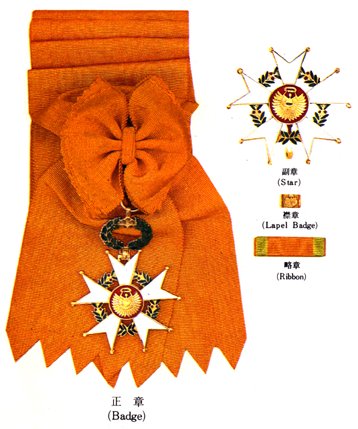
청룡장
(Blue Dragon)
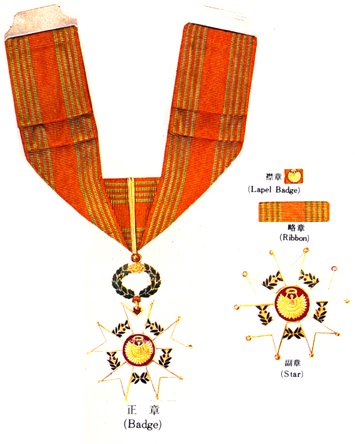
맹호장
(Brave Tiger)
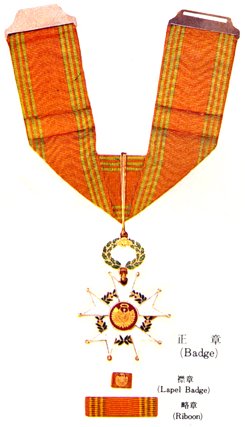
거상장
(Great Hero)
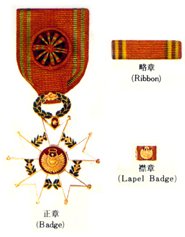
백마장
(White Horse)
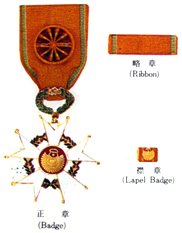
기린장
(Chinese Unicorn)
Shin-Soo Choo Avoids Military Duty by Leading South Korea to Gold Medal
By Knox Bardeen, November 19 2010
The Asian Games was more than just a regional Olympic-style sporting event with national bragging rights on the line for 45 countries, at least for Cleveland Indians outfielder Shin-Soo Choo. When Choo led the South Korean baseball team to the gold medal on Friday, he may have just slugged his way out of a mandatory military commitment with his home country.
Choo hit .300 with 22 home runs for the Indians in 2010, and has been playing in the States since 2005. But, according to South Korean law, every able-bodied male must serve in their military for two years prior to his 30th birthday. Choo, who turned 28 in July, was in danger of having to leave Major League Baseball in the prime of his career to complete his tour of duty in South Korea. The South Korean government did give Choo an interesting option prior to the Asian Games. All Choo had to do was bring home the gold medal in baseball, and the powers would consider letting Choo out of his obligation to serve in the military. Choo went 8-for-14 with three home runs and drove in 11 runs during the tournament. It was almost as if you could hear Choo’s sigh of relief all the way to the United States from Guangzhou, China – the site of the Asian Games. The Indians and their fans breathed that same collective sigh. “I am kind of dreaming right now,” Choo told reporters after the gold-medal game. “If I (told you I) didn’t think about the military service, I might be a liar.” Official word is still yet to come, but it is expected that Choo will be now be exempt from military service and allowed to return to Cleveland for the 2011 season.
Had South Korea not won the gold medal, Choo, who has a home in Buckeye, Ariz., had a backup plan — become a U.S. citizen. It looks like he won’t have to study up on U.S. History to continue playing baseball in the States.
Korean Olympians to Cash In on Medals
02-18-2010 19:37
By Kang Seung-woo Staff Reporter at Korea Times Feb. 18, 2010
South Korean medalists from the 2010 Vancouver Winter Olympics have enshrined themselves into the pantheon of the nation’s great athletes. And while smelling the rarefied air, they have also hit the jackpot with the pension and bonus money that go along with winning medals at the quadrennial sports festival. South Korea’s gold medalists long-track speed skaters Lee Sang-hwa and Mo Tae-bum and short tracker Lee Jung-su – will receive a monthly pension of 1 million won ($871) for 60 years. According to Korea Sports Promotion Foundation (KSPF) policy, an Olympic gold medalist can earn 1 million won a month along with 90 pension points, while silver and bronze winners can make 450,000 won (30 points) and 300,000 (20), respectively. One million won is the maximum one athlete can earn per month, regardless of the number of medals he or she wins. An athlete who reaches 110 pension points will also earn a million per month, regardless of whether that athlete won a medal. Also, once athletes surpass 110 points, they receive one-time bonuses dependent on what color of medal they win. If an athlete wins a gold medal, they receive 5 million won for every 10 points over 110, or 1.5 million won for a silver or bronze. For example, Lee Sang-hwa already had 30 points before the Olympics began. The gold medal vaulted her up to 120 points, and earned her 5 million won. Mo’s gold medal brought him to 115 points. His silver medal Wednesday earned him an extra 4.5 million won – 1.5 million won for every 10 points above 110. Lee Jung-su had 20 points entering the Games and has now reached 110. He is now eligible for the full pension and will earn bonuses on any subsequent medal he wins. Long-track speed skater Lee Seung-hoon, who won silver in the men’s 5,000 meters, added 30 points to reach 132, earning him 3 million won. In addition to the pension and the bonuses, the medal winners will take a big wad of cash from the government and IOC member and former Samsung Chairman Lee Kun-hee. The government promised 40 million won for each gold medal, 20 million won for a silver and 12 million won for a bronze. Lee has said he’ll add half of what the government gives (prizes of 20, 10 and six million won).
ksw@koreatimes.co.kr
Footnotes:
- The word Girin is commonly translated as giraffe. It is actually a mythical animal, which only appears in times of extreme peace and prosperity. It is sometimes referred to as the Chinese Unicorn (also spelled as Kylin, Chi-lin, and in Japan, as Kirin).
- 상훈법시행령 [시행 1974. 10. 23.] [대통령령 제7289호, 1974. 10. 23., 일부개정]
- 상훈법시행령 [시행 1984. 1. 23.] [대통령령 제11336호, 1984. 1. 23., 일부개정]
- Decorations Law Enforcement Decree 상훈법 시행령, Presidential Decree #26838 대통령령 제26838호, dated 2015.12.31 and implemented on 2016.1.1.[시행 2016.1.1.], partial revision 일부개정.
